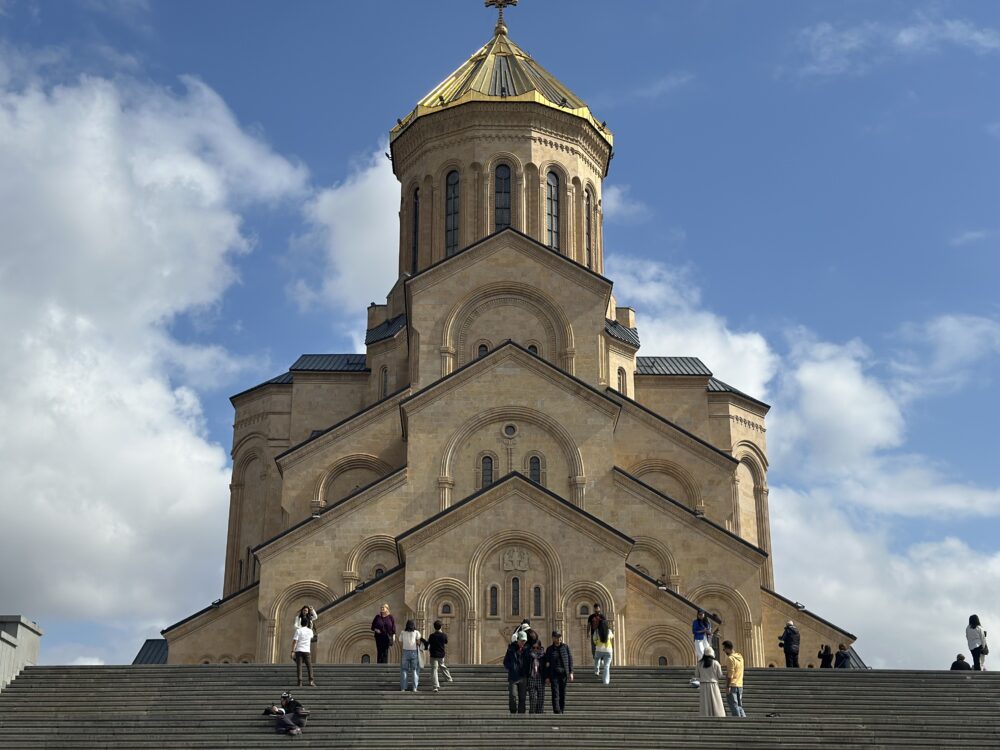Living story: Exploring Tbilisi’s Old Town on foot allows visitors to absorb the details of the historical centre of Georgia’s capital city. Photo: Marion Smith
Once overlooked by mainstream tourism, Georgia’s capital Tbilisi has quietly become one of the most intriguing in Eastern Europe.
The Georgian city, nestled along the Mtkvari River, framed by soft rolling hills, blends centuries of history with a growing creative energy.
Its cobbled streets, sulphur baths and vibrant food culture sit comfortably alongside futuristic architecture and new design districts, evidence of a city reinventing itself while staying rooted in tradition.
For South Africans, there is added appeal — Georgia offers visa-free entry for up to one year, making it an accessible option for longer stays or cultural getaways.
Tbilisi’s Old Town remains the city’s beating heart. Exploring it on foot reveals the layers of influence that have shaped the city over centuries.
Local guide Guran Alaphishvili, who has worked in the tourism industry for nearly two decades, says the district tells a living story of coexistence that continues to evolve.
The Jewish, Armenian and German quarters stand as quiet reminders of that multicultural past, with synagogues, churches and traditional homes sharing the same narrow alleys.
The area feels less like a preserved attraction and more like a functioning neighbourhood where history breathes through the walls.
One unassuming highlight is Kneina, a small restaurant where an old clay bread-oven was uncovered during renovations. The area, historically known for its bakeries, still uses wood-fired ovens to bake puri, a Georgian flatbread with a smoky crust and distinct aroma that drifts through the streets.
The rhythmic work of the bakers captures a small, but enduring, part of local life.
Beyond its landmarks, Tbilisi reveals itself in quieter details: carved wooden balconies, peeling pastel doorways and vine-draped courtyards tucked behind heavy gates. Each tells its own story of time and change.
Across the city, Soviet-era apartment blocks are offering new surprises. Murals and mosaics from the 1950s and 1960s, long neglected, are being uncovered and restored. Once utilitarian facades display cosmic scenes, folk imagery and geometric patterns that record the city’s complex post-war years and artistic resilience.
Across the Mtkvari River, the city’s modern face emerges. The Bridge of Peace, a glass and steel structure designed by Italian architect Michele De Lucchi, connects old and new Tbilisi in both geography and spirit. At night, its illuminated curves reflect across the water, forming one of the city’s most photographed silhouettes.
Above the river, the Chronicles of Georgia monument dominates the skyline. The stone columns, carved with scenes from history and scripture, were created by sculptor Zurab Tsereteli in the 1980s and it remains one of the city’s most striking modern landmarks.
The Holy Trinity Cathedral, also known as Sameba, with its gold dome visible from nearly every district, stands as another symbol of the country’s post-Soviet identity, grand, new and deeply rooted in the Orthodox faith.
 Landmark: The Holy Trinity Cathedral stands as a symbol of the country’s post-Soviet identity, rooted in the Orthodox faith.
Photo: Marion Smith
Landmark: The Holy Trinity Cathedral stands as a symbol of the country’s post-Soviet identity, rooted in the Orthodox faith.
Photo: Marion Smith
The Abanotubani district, famous for its domed sulphur baths, is one of the oldest parts of Tbilisi. The thermal waters have drawn visitors for centuries, including poet Alexander Pushkin, who wrote about his experience here in the 19th century.
The baths are an important ritual for locals, a space for rest, conversation and renewal beneath the domes that define the Old City skyline.
Afterwards, many head to Ethnograph Restaurant, where traditional folk dance and singing accompany generous Georgian meals. Dishes like khachapuri, the country’s beloved cheese-filled bread and grilled meats are paired with local Saperavi wine, showcasing the depth of Georgian hospitality.
Street vendors have found their own playful nod to that heritage with wine-flavoured ice cream, a symbol of how old traditions are being reimagined for a new generation.
The city’s ongoing revival is perhaps best seen at Stamba, a former Soviet publishing house turned into a hotel and cultural hub. Its design, with raw concrete, vintage printing presses and indoor greenery, reflects Tbilisi’s ability to turn history into something forward-looking.
Inside, creative studios, a coffee roastery and one of the most photographed lobbies in Europe make Stamba a workspace and a meeting point for the city’s creative scene.
Tbilisi is a city in transition, ancient and modern, restrained yet expressive. From its restored courtyards and riverside cafes to its reimagined industrial buildings, it tells a broader story about Georgia — a country balancing memory and reinvention.
With visa-free entry for South African passport holders, and a growing reputation as the cultural heart of the Caucasus, Tbilisi is finding its place on the global map through character, creativity and quiet confidence.